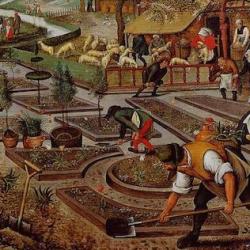Deepak Lal holds the James S. Coleman Professorship of International Development Studies at UCLA, and has produced a fascinating cross-disciplinary and cross-cultural study of the relation of culture and development, Unintended Consequences (Oxford, 1998). Many of his arguments are unpersuasive, but stimulating nonetheless.
One of Lal’s main themes is to explain the differences between “the West and the Rest,” and he traces the difference to cultural and cosmological factors. These unique features of Western civilization, in turn, are traceable to medieval Christianity, particularly the effects of the work of Popes, Gregory I and Gregory VII. Combined, the achievements of these two popes nurtured the development of individualism in the West, and a culture held together by guilt rather than by shame. There’s a lot here to unpack, and here are a few notes.
1) Lal sees Gregory I’s contribution to the development of Western individual embodied particularly in his instructions to Augustine, missionary to England. Relying on Jack Goody’s work, Lal argues that the central thrust of Gregory’s varied instructions was to dissolve the ties between extended family and property: “all the rejected practices had one common aspect. They concerned ‘strategies of heirship’: inheritance of familial property, the provision of an heir, and maintaining status in an advanced stratified agricultural society’” (the quotation is from Goody). For example, as Goody explained, “marriage between kin serves to reinforce ‘family’ ties. These particular forms also prevent female heiresses from removing property from the ‘family,’ and thus combat the problem of the absence of sons.” By forbidden marriage within certain close degrees of consanguinity, Gregory was undermining these familial protections of inheritance and property. Lal’s assessment is highly uncharitable: “These sixth-century papal injunctions . . . inhibited a family from retaining its property and promoted its alienation. This is, of course, what the church wanted for, from its inception, it had grown and become a rich landlord through gifts and donations.”
2) Gregory VII’s reforms were aimed at “recovering the church’s pillaged patriomony,” reasserting the church’s claims over real estate. Goody writes, “The reforms instigated at this time included the enforcement of celibacy of the clergy and the wide extension of the prohibitions on marriage, the latter tending to weaken the control of property by kin, the former helping to retain in Church hands what had already been secured.” Thus the Papal Revolution enabled the church to protect its material self-interests. (I have argued in my dissertation and in an article in Modern Theology that the struggle of the 11th century was more a struggle over control of “sancta” than over control of lands, though perhaps there are interrelations.)
3) How these two papal reforms promoted “individualism” is difficult to see. Lal defines individualism as “the view that society is constituted of autonomous, equal units, namely separate individuals and that such individuals are more importantly, ultimately, than any larger constituent group. It is reflected in the concept of individual property, in the political and legal liberty of the individual, in the idea of the individual’s direct communication with God” (this quoted from Alan Macfarlane). Lal focuses on the property issue, but the steps between the church’s disruption of older property customs and the development of individual property ownership are not well marked.
4) Another of Christianity’s inadvertent contributions to the development of the West was the doctrine of original sin and the notion of guilt. Here Augustine of Hippo rather than one of the Gregorys is the chief culprit. Guilt, Lal argues, is what has held Western culture together. It was used by the church as a mechanism of social control, especially for the control of sexual passion. Here again, property issues are prominent for Lal: Sexual passion is disruptive of marriage and therefore of inheritance and property, and making sexual passion culpable was a way of addressing the problems caused by Gregory I’s assault on traditional familial modes of property ownership: “To counter these deleterious effects on the internalized mores that had hitherto maintained social order [Lal is referring to traditional notions of “shame”], the church, through what I have called Augustine’s ‘mutation,’ put original sin at the fountainhead of its doctrines and created a guilty society in which a fear of Purgatory was enough to make Christians eschew as best as they were able the seven deadly sins or else seek absolution from the church’s functionaries.” Lal cites de Tocqueville’s claim that Americans were cemented together “by the emotions of ‘guilty’ or ‘shame’ engenedered in the process of socialization.”
5) Individualism, however, tends to undermine guilt, especially in its recent “postmodern” forms where all constraints, conventions, and manners are treated as mere cultural constructs that can be changed at a whim. In something of a variation of Bell’s concept of the “cultural contradictions of capitalism,” Lal concludes that the West’s strengths are producing the forces that will bring their demise.
6) This is not inevitable, however, since “guilt” is a particularly Western social “glue.” He suggests that developing countries can share in the benefits of Western development without sharing their culture and cosmology in every respect. Eastern peoples, whose social glue is “shame” (more familial and corporate) rather than “guilt” can develop economically without accepting the contradictory burden of the West.
Lal has much more in this intriguing study, and there is much here to disagree with. But one of the positive things about the book is the explicit recognition that cultural and religious factors are crucial in economic development.














